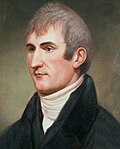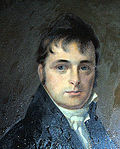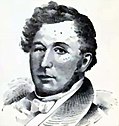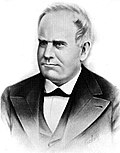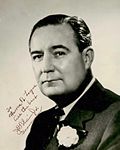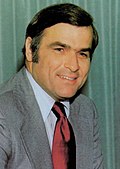Top Qs
Timeline
Chat
Perspective
List of governors of Missouri
From Wikipedia, the free encyclopedia
Remove ads
The governor of Missouri is the head of government of the U.S. state of Missouri and the commander-in-chief of the Missouri National Guard. The governor has a duty to enforce state laws and the power to either approve or veto bills passed by the Missouri Legislature, to convene the legislature and grant pardons, except in cases of impeachment.
Remove ads
The current governor is Republican Mike Kehoe, who took office on January 13, 2025.
Remove ads
List of governors
Summarize
Perspective
Louisiana was purchased from France in 1803, with it being proclaimed in St. Louis in Upper Louisiana on March 10, 1804, by Amos Stoddard, who remained as military commander of the region until October 1, 1804, when Orleans Territory was split from it. The remainder was designated the District of Louisiana and placed under the jurisdiction of Indiana Territory and its governor, William Henry Harrison.[3][4]
Louisiana Territory and Missouri Territory
The District of Louisiana was organized as Louisiana Territory on July 4, 1805;[5] it was renamed Missouri Territory on June 4, 1812, after the admission of the state of Louisiana.[6] It had four governors appointed by the president of the United States, including both Meriwether Lewis and William Clark of the Lewis and Clark Expedition.
State of Missouri
Missouri was admitted to the union on August 10, 1821.[25]
The original constitution of 1820 created the offices of governor[26] and lieutenant governor,[27] to serve terms of four years[28] without being able to succeed themselves.[29] Terms were shortened to 2 years in 1865,[30] with a limit of serving no more than four out of every six years.[31] They were returned in 1875 to the four-year term and limit on succession of the 1820 constitution,[32] and the term limit changed to two terms in 1965.[33] Originally, the lieutenant governor would act as governor in the event of a vacancy;[34] a 1968 amendment made it so that the lieutenant governor becomes governor in that situation.[33]
A group including the governor, lieutenant governor, and members of the Missouri General Assembly, proclaimed Missouri's secession from the Union on October 31, 1861,[35] and it was admitted to the Confederate States of America on November 28, 1861.[36] The Confederate government elected two governors, but only had any control in the south of the state, and was forced into exile in Marshall, Texas, after the Battle of Pea Ridge in March 1862.
Remove ads
Confederate governors

During the Civil War, after the capture of Jefferson City by the Union, a constitutional convention declared the office then held by Governor Claiborne Fox Jackson to be vacant.[86] In October, Jackson, Lieutenant Governor Thomas Caute Reynolds, and some members of the General Assembly, organized at Neosho and passed an Ordinance of Secession. This Confederate government never displaced the government in Jefferson City, and Missouri remained in the Union through the entire war. Jackson continued on as governor until his death on December 6, 1862, at which time Reynolds took over, serving until he fled to Mexico in June 1865 after the end of the war.[207]
Remove ads
See also
Notes
- Wilkinson left the territory August 16, 1806, after which point Secretary of the Territory Joseph Brown acted as governor.[7]
- Lewis died in Tennessee while en route to Washington to answer complaints about his actions as governor; it is unknown if he was murdered or died by suicide.[12] Secretary of the Territory Frederick Bates acted as governor until his successor arrived.[16]
- Howard resigned to accept a commission as brigadier general in the United States Army.[16]
- Clark was nominated on May 31, 1813;[20] though his nomination notes that he had been appointed during a Senate recess, no specifics on that appointment have been found. He was confirmed by the Senate on June 2,[21] and the confirmation was communicated to the president on June 16.[22] He was reconfirmed by the Senate on January 21, 1817,[23] and on January 24, 1820.[24]
- Under the 1820 constitution, governors were ineligible for four years after the end of their term.[40]
- Modern sources tend to say Bates took office on November 15; however, while this was the date McNair delivered his farewell address, Bates was not sworn in until November 17.[44]
- Special election to fill the remainder of Frederick Bates' term.
- Dunklin resigned to be Surveyor General for Missouri and Illinois.[51]
- Polk resigned, having been elected to the United States Senate.[74]
- Special election to fill the remainder of Trusten Polk's term.
- Jackson was pro-Confederate, and fled Jefferson City on June 17, 1861, after the Battle of Boonville in which Union forces gained control of the capital. The pro-Union constitutional convention declared his office vacant, and elected a new provisional governor, on July 31.[86] Jackson would soon establish a Confederate-aligned government in Neosho, Missouri.
- Under the 1865 constitution, governors were ineligible to serve more than four years in six.[95]
- Brown instead ran unsuccessfully for Vice President of the United States.[99]
- Woodson also represented the Liberal Republican Party.[55]
- Hardin also represented the Liberal Republican Party.[55]
- Under the 1875 constitution, governors were ineligible to be re-elected as their own successor.[111]
- The election was very close, and the House of Representatives refused to certify Donnell's election until February 26, 1941, after being ordered to do so by the Missouri Supreme Court.[161][163]
- Under the 1945 constitution, governors were ineligible to be re-elected as their own successor.[167]
- Under a 1965 amendment to the constitution, governors are ineligible to be elected more than twice.[181]
- Carnahan died in a plane crash while campaigning for a seat in the United States Senate.[190]
- The plane crash that killed Carnahan occurred on October 16; his body was not identified until October 18, and shortly thereafter Wilson was sworn in.[193]
- Holden lost the Democratic nomination to Claire McCaskill.
- Greitens resigned due to allegations of sexual assault and campaign finance impropriety.[202]
Remove ads
References
External links
Wikiwand - on
Seamless Wikipedia browsing. On steroids.
Remove ads




